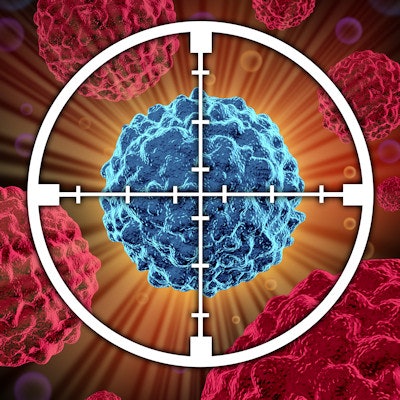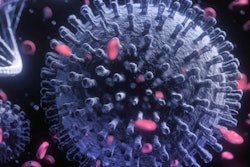
Greater use of hypofractionated dosing regimens has helped radiation oncology sites deliver radiation therapy to cancer patients in England during the COVID-19 pandemic, offsetting a massive decline in treatment sessions overall, according to a study published on 22 January in Lancet Oncology.
The study from the University of Leeds with Public Health England and the Royal College of Radiologists evaluated how radiation therapy practice changed on a number of fronts during the first wave of the outbreak.
 Dr. Katie Spencer, PhD. Image courtesy of University of Leeds.
Dr. Katie Spencer, PhD. Image courtesy of University of Leeds.Compared with the same periods in 2019, in 2020 the number of radiotherapy courses dropped by 19.9% in April, 6.2% in May, and 11.6% in June, reported Dr. Katie Spencer, PhD, a fellow in clinical oncology at Leeds Teaching Hospitals National Health Service (NHS) Trust, and colleagues. The data reflect guidelines during the pandemic and more appropriate use of radiation therapy in some key areas, such as short courses with high doses (hypofractionated) where appropriate, delays for nonurgent care, and increased use of radiation therapy as an alternative to surgery.
"Although radiotherapy activity decreased during the first wave of the pandemic, our data suggest that the overall impact of this decline is likely to be modest," said the group. "In addition, radiotherapy appears to have mitigated against some of the indirect harms of the pandemic by maintaining curative treatment options despite the challenges facing surgical services."
Search for value in cancer care
Spencer is a specialist on health economics and value in cancer care, particularly the use and cost-effectiveness of radiotherapy, and an experienced user of routine NHS healthcare data to understand variation and improve value and outcomes. Her team's study was designed to evaluate the impact of the COVID-19 pandemic on radiotherapy services across the NHS in England and guidelines issued in response to the outbreak. About one-third of cancer patients typically undergo radiation therapy.
"Alongside surgery and systemic anticancer therapy, radiotherapy plays a major part both as a curative treatment and in the palliation of [localized] symptoms from advanced disease," the authors wrote. "At the outset of the pandemic, all three treatment modalities were affected by constraints on COVID-19 testing and staff shortages."
Researchers evaluated the use of radiation therapy delivered by all 52 NHS radiation therapy providers in England pre-pandemic and through the end of June 2020. During a lockdown period -- from 23 March to 28 June -- the total number of radiation treatment courses dropped by 3,263 across the NHS in England, while the number of treatment appointments was down by 119,050, the authors reported.
The declines were in line with national and international guidelines for prioritizing/triaging patients and managing care during the pandemic.
"The disproportionately greater fall in treatment attendances largely reflects a rapid increase in the use of ultra-hypofractionated treatment regimens across several [tumor] sites," the authors noted.
For example, in April 2020, researchers reported dramatically more use of a treatment regimen that specified 26 Gy in five fractions for the neoadjuvant treatment of breast cancer, as opposed to the 40 Gy in 15 fractions that was more common pre-pandemic.
"A marked increase in the use of ultra-hypofractionation in the neoadjuvant treatment of rectal cancer was also observed, with a reduction in the use of less than 2 Gy per fraction regimens," they said.
Other key findings
The researchers also reported that compared with other age groups, they found more of a decline in treatment for people over the age of 70, which could reflect higher risk of the patients due to age and comorbidities, as well as the ability to defer care for certain conditions such as prostate cancer and nonmelanoma skin cancer.
In tumor types that typically require more immediate treatment, such as cancers of the rectum, bladder, and esophagus, the researchers observed an increase in the number of treatment courses. Spencer and colleagues suggested that this could signal the use of radiation therapy as an alternative to surgery. For example, the number of curative courses for bladder cancer rose by 143.3% in May 2020 relative to May 2019.
Areas of concern, however, include a decline in the number of palliative treatment courses and a persistent decline in radiation therapy overall in June 2020 relative to June 2019. NHS data show that the number of referrals for possible symptomatic cancer was 21% lower in June 2020 compared with the same period in 2019, the authors noted.
"New diagnoses were suppressed by 26%, which is probably a key contributor to the ongoing suppression in radiotherapy activity up to June 2020," Spencer et al wrote.
It's possible that this trend will have an effect on outcomes as the data are followed over time.
"As COVID-19 cases again rise, these data are crucial for modeling indirect harms of the pandemic and establish a new baseline for radiotherapy treatments from which to plan for the ongoing delivery of care throughout subsequent pandemic waves and into the recovery beyond," the authors wrote. "They also reinforce the need to address any persisting delays in cancer diagnostic pathways."



















